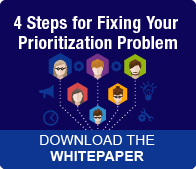Change saturation is quickly becoming one of the biggest challenges in organizations across the globe. Our Change Management Consultants see it everywhere they go. “Sure, we can do that.” “Oh, that initiative will improve sales. Let’s get going on it quickly.” While there certainly isn’t a shortage of good ideas out there the bottom line is almost every organization we know has too many initiatives chasing far too few resources. 
In our change management training programs, we talk about how one turn of the strategic initiative wheel at the top creates constant spinning of the change wheel further down the organization. Whether organizations have 5,000 or 50,000 employees, they are all whirling with activity.
Focus Down to Speed Up
What is especially shocking to us is when organizations have so much going on they lose track of how many projects are in the works, where resources are being spent, and whether or not the initiatives being pursued are really the strategic priority for the organization! In one recent example, we asked a CEO how many priority, strategic changes his company had going on at that moment. His response? “We have over 20 top priorities this year.” 20!?! In our opinion, an organization with 20 top priorities really has no priorities at all.
What is our advice to organizations like this? Focus down to speed up! What we mean by this is that to go faster, you have to actually slow down by either having fewer initiatives on the organizational change plate, or by doing a better job at sequencing those changes. It may sound counter-intuitive, but slowing down ultimately results in greater speed.
4 Steps to Fix the Problem
Based on our 30+ years focused solely on helping organizations accelerate change project implementations, we’ve compiled a few best practices to assist organizations who are dealing with change saturation.
Step One: Know Everything Your Organization is Working On! The best starting place is to complete an inventory of every existing and proposed project within your organization. Consolidate all projects into a single master schedule to provide the visibility required to make informed decisions on capacity to implement and resource capability for existing and new projects. It is critical to include both projects that are in the pipeline and current initiatives. Your list should include what is going on at all levels of the organization, and the time frames for completion.
Step Two: Categorize by Project Type. Once you have a full list of projects, the next step is to categorize your projects by type. Remember, depending on your strategic priorities, some categories are going to be more important than others. Examples of standard project-type categories include:
· Mandatory/Regulatory/Compliance
· Maintenance
· Business enhancement
· Cost efficiencies/reduction
· Business growth
Step Three: Prioritize by Applying Consistent Selection Criteria. One of the major mistakes made by organizations is that they do not use consistent standards to determine project prioritization. We encourage organizations to use factors that touch on all five of the AIM success metrics; on time, on budget, all business, technical, and human objectives met. Examples of prioritization criteria include (but are not limited to):
· Initiatives with the greatest potential ROI
· Projects that are the most urgent
· The inter-dependence of an initiative with other critical projects
· Initiatives that are high-risk, high-gain
These criteria can then be weighted to ensure mandatory/regulatory projects will be automatically included, while projects with questionable business value can be eliminated. Afterwards, using the agreed upon consistent selection criteria, decisions can be made on which projects should be funded and which should not.
Step Four: Implement. Once you have created your prioritized list, the real work of implementation begins! Implementation is a ferocious, resource-consuming activity. In fact, once a strategy is designed, you are only 15% of the way there! You still have 85% of the journey ahead. That is why you must create a realistic “Implementation Plan” and not just an “Installation Plan” for all your projects.
Although most organizations we work with think they are “special and unique,” the truth of the matter is everyone, everywhere is struggling with change fatigue. While the above four steps may not be a magic fix for the change saturation problem, they can certainly provide the structure, process, and tools needed to support better decision-making, and the ability to do a much better job of sequencing over time the many implementations you have going on.


